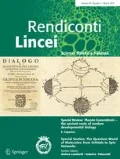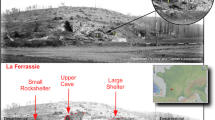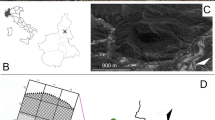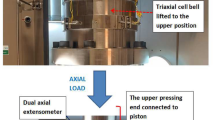Abstract
This work studies the Heliocaminus Baths. From an architectural point of view, this is a special and unique building in the complex of the Hadrian’s Villa in Tivoli. This research is carried out with a multidisciplinary approach combining petrophysical, petrographic and mineralogical characterization with the techniques of digital survey. The purpose of the research is to contribute to the understanding of Roman construction through the study of materials and from architectural aspects. Using mineral-petrographic and physical analysis, a set of samples (mortars and stones) was investigated for composition and physical properties (density, porosity, water absorption, mechanical strength, etc.). In the case of mortars, these parameters, together with the particle size distribution and the binder/aggregate ratio determined in two ways using image analysis (on thin sections and on specimens), have shown a relationship between the physical and compositional characteristics and the function of mortars within the structure of the Heliocaminus Baths. However, in some cases, different characteristics were detected between the mortars belonging to the same masonry and with same function in the building, showing a slight inhomogeneity in the production of mortars. Furthermore, some relationships between compositional, physical aspects (i.e. porosity, sorting and size of aggregate) and mechanical strength have been found. All the gathered data, linked to the point cloud 3D model, allowed an accurate location of the traces from the construction story of this structure.














Similar content being viewed by others
References
Recommendations Nor.Ma.L. 3/80 (1980) Stone materials: sampling (reprint 1988)
Antonelli F, Columbu S, Lezzerini M, Miriello D (2013) Petrographic characterization and provenance determination of the white marbles used in the Roman sculptures of Forum Sempronii (Fossombrone, Marche, Italy). Appl Phys A 115:1033–1040
Antonelli F, Columbu S, De Vos Raaijmakers M, Andreoli M (2014) An archaeometric contribution to the study of ancient millstones from the Mulargia area (Sardinia, Italy) through new analytical data on volcanic raw material and archaeological items from Hellenistic and Roman North Africa. J Archaeol Sci 50:243–261
Attanasio D, Mesolella G, Pensabene P, Platania R, Rocchi P (2009) EPR and petrographic provenance of the architectural white marbles of three buildings at Villa Adriana. In: Maniatis Y (ed), Asmosia VII. Proceeding 7th international conference ASMOSIA, Thassos 2003, Bull de Corresp Hell Sup, 51, Athens, pp 57–369
Attanasio D, Bruno M, Prochaska W, Yavuz AB (2013) The Asiatic marbles of the Hadrian’s Villa at Tivoli. J Archaeol Sci 40:4358–4368
Bernardi A, De Rita D, Funiciello R, Villa IM (1982) Chronology and structural evolution of Alban hills volcanic complex, Latium, Italy. Guidebook AVCEI. Workshop on the explosive volcanism. S. Martino al Cimino, Viterbo
Bertorino G, Franceschelli M, Marchi M, Luglié C, Columbu S (2002) Petrographic characterisation of polished stone axes from Neolithic Sardinia, archaeological implications. Per Miner 71:87–100
Binda L, Baronio G (1986) Indagine sull’aderenza tra legante e laterizio in malte ed intonachi di cocciopesto. Boll d’Arte 35(36):109–115
Camiz A (2004) La cosiddetta “Roccabruna” ed il dies imperii. In: Basso Peressut L, Caliari PF (eds) Villa Adriana. Environments. Milano, vol. 2, pp 121–129
Cicerchia P (1985) Sul carattere distributivo delle terme con Heliocaminus di Villa Adriana. Xenia 9:47–60
Collepardi M (1993) La produzione del calcestruzzo antico e moderno. Atti del Convegno di Studi «Calcestruzzi antichi e moderni: Storia, Cultura e Tecnologia». Bressanone, Libreria Progetto Editore, Padova, pp 181–192
Columbu S, Verdiani G (2011) From the small elements to the urban scale: An investigation where petrophysical study of materials and architectural shape analysis try to read a masterplan in the Hadrian’s Villa, Tivoli (Rome, Italy). In: Proceedings of 16th international conference on cultural heritage and new technologies (CHNT 2011) Wien. 14–16 November 2011, Urban archaeology and prospection, Museen der Stadt Wien—Stadtarchäologie. vol 1, part 3, pp 273–293
Columbu S, Verdiani G (2014) Digital survey and material analysis strategies for documenting, monitoring and study the romanesque churches in Sardinia, Italy, lecture notes in computer science, vol 8740. Springer, Heidelberg, pp 446–453
Columbu S, Guccini G, Verdiani G (2013) Petro-physical characterization and 3D digital modeling for geometric reconstruction of the Neolithic “domus de janas” of Sedini field (North-Sardinia, Italy). Adv Comput Sci Int J 2(5):70–80
Columbu S, Antonelli F, Lezzerini M, Miriello D, Adembri B, Blanco A (2014a) Provenance of marbles used in the Heliocaminus Baths of Hadrian’s Villa (Tivoli, Italy). J Archaeol Sci 49:332–342
Columbu S, Gioncada A, Lezzerini M, Marchi M (2014b) Hydric dilatation of ignimbritic stones used in the church of Santa Maria di Otti (Oschiri, northern Sardinia, Italy). Ital J Geosci 133:149–160
Columbu S, Cruciani G, Fancello D, Franceschelli M, Musumeci G (2015) Petrophysical properties of a granite–protomylonite–ultramylonite sequence: insight from the Monte Grighini shear zone, central Sardinia, Italy. Eur J Miner 27:471–486
Crisci GM, De Francesco AM, Gagliardi F, Mercurio P, Gattuso P, Miriello D (2002) L’analisi composizionale delle malte: Un valido mezzo per risalire alle fasi costruttive. Risultati preliminari. In: D’Amico C (ed) Proceedings of II Congresso nazionale di archeometria. Pàtron editore, Bologna, pp 485–494
De Luca R, Cau Ontiveros MA, Miriello D, Pecci A, Le Pera E, Bloise A, Crisci GM (2013) Archaeometric study of mortars and plasters from the Roman City of Pollentia (Mallorca-Balearic Islands). Per Miner 82:353–379
Fischer P (1983) Anmerkungen zur Brennfarbe von Tonen. Ceramic Forum International. Berichte Deutsche Heramische Gesellschaft 8:320–327
ISRM International Society For Rock Mechanics (1972) Suggest method for determining the point load strength index. ISRM (Lisbon, Portugal). Committee on field tests. Document n.1, pp. 8–12
ISRM, International Society For Rock Mechanics (1985) Suggest method for determining the point load strength. ISRM commission for testing methods, Working group on revision of the point load test methods. Int J Rock Mech Min Sci Geomech Abstr 22:51–60
Kreimeyer R (1987) Some notes on the firing colour of clays bricks. Appl Clay Sci 2:175–183
Lapuente P, León P, Nogales T, Royo H, Preite-Martinez M, Blanc Ph (2012) White sculptural materials from Villa Adriana: study of provenance. In: Gutiérrez Garcia A, Lapuente P, Rodà I (eds) Interdisciplinary studies on ancient stone. Proceedings of the IX ASMOSIA conference, Tarragona, pp 364–375
Lezzerini M, Antonelli F, Columbu S, Gadducci R, Marradi A, Miriello D, Parodi L, Secchiari L, Lazzeri A (2014) The documentation and conservation of the cultural heritage: 3D laser scanning and GIS techniques for thematic mapping of the stonework of the façade of St. Nicholas church (Pisa, Italy). Int J Archit Herit Conserv Anal Restor. doi:10.1080/15583058.2014.924605
MacDonald WL, Pinto JA (2006) Villa Adriana; la costruzione e il mito da Adriano a Louis I Kahn. Architettura Paperback, Mondadori Electa, Milano, p 400
Macciotta G, Bertorino G, Caredda A, Columbu S, Coroneo R, Franceschelli M, Marchi M, Rescic S (2001) The S.Antioco of Bisarcio Basilica (NE Sardinia, Italy): water-rock interaction in ignimbrite monument decay. In: Cidu, Swets, Zeitlinger, Lisse (eds) Water–rock interaction (WRI-10). Balkema, Rotterdam, pp 415–418
Maravelaki-Kalaitzaki P, Bakolas A, Moropoulou A (2003) Physico-chemical study of Cretan ancient mortars. Cem Concr 33:651–661
Melis S, Columbu S (2000) Matériaux de construction en époque romaine et aves les anciennes carrières: l’exemple du théâtre de Nora (Sardaigne SO, Italie). In: Lorenz J, Tardy D, Coulon G (eds) Proceedings of La pierre dans la ville antique et médiévale. Analyse méthodologie et apports, Argenton sur Creuse, France, 29–31 March 1998. Saint-Marcel, Musée d’Argentomagus (ed), pp 103–117
Miriello D, Barca D, Bloise A, Ciarallo A, Crisci GM, De Rose T, Gattuso C, Gazineo F, La Russa F (2010) Characterisation of archaeological mortars from Pompeii (Campania, Italy) and identification of construction phases by compositional data analysis. J Archaeol Sci 37:2207–2223
Miriello D, Antonelli F, Apollaro C, Bloise A, Bruno N, Catalano E, Columbu S, Crisci GM, De Luca R, Lezzerini M, Mancuso S, La Marca A (2015) New data about the ancient mortars from the archaeological site of Kyme (Turkey): compositional characterization. Per Miner (in print)
Morbidelli L (2003) In: Le rocce e i loro costituenti. Bardi Editore, Roma
Palmström A (1995) RMi—a rock mass characterization system for rock engineering purposes. Ph D. thesis, University of Oslo, Norway, 430 pp
Peccerillo A (2005) Plio-quaternary volcanism in italy. petrology, geochemistry, geodynamics. Springer, Heidelberg, p 365
Pensabene P, Antonelli F, Lazzarini L, Cancelliere S (2012) Provenance of marble sculptures and artifacts from the so-called Canopus and other buildings of “Villa Adriana” (Hadrian’s Villa, Tivoli, Italy). J Archaeol Sci 39:1331–1337
Pollione MV (15 BC) De Architecture. Vol. II. In: Cesariano C, De Architectura Libri Dece, 1521, Como
Salvatori A, Trucchi D, Guidobaldi F (1988) The marbles used in the decorations of Hadrian’s Villa at Tivoli. In: Herz N, Walelkens M (eds) Classical marble: geochemistry, technology, trade. Kluwer Academic Publishers, Dordrecht, pp 177–185
Salza Prina Ricotti E (2000) Villa Adriana, il sogno di un imperatore. L’Erma di Bretschneider, Rome
Schmidt-Reinholz Ch (1985) Remarks on the complete colouration of heavy-clay bodies. Interbrick 1(3):36–38
Stepkowska ET, Jefferis SA (1992) Influence of microstructure on firing colour of clays. Appl Clay Sci 6:319–342
Verdiani G, Columbu S (2010) E. Stone, an archive for the Sardinia monumental witnesses. Third International Conference, EuroMed 2010, Lemessos, Cyprus, November 8–13, 2010. Lecture Notes in Computer Science (LNCS), Springer, Heidelberg, vol 6436/2010, pp 356–372
Verduchi P (1975) Le Terme con cosiddetto Heliocaminus a Villa Adriana. Quaderni dell’Istituto di Topografia Antica, Università di Roma 8:55–95
Vola G, Gotti E, Brandon C, Oleson JP, Hohlfelder RL (2011) Chemical, mineralogical and petrographic characterization of roman ancient hydraulic concretes cores from Santa Liberata, Italy, and Caesarea Palestinae, Israel. Per Miner 80:317–338
Voskuil J, Van Der Giesen D (1959) Die Farbbildung in roten und gelben Ziegelsteinen. Sprechsaal 92:529–533
Acknowledgments
Stefano Columbu, Dipartimento di Scienze Chimiche e Geologiche of Cagliari University (UNICA), Italy, was responsible for geomaterial mapping and sampling of the Heliocaminus Baths (2010). Giorgio Verdiani, Dipartimento di Architettura of the Florence University (UNIFI), Italy, was responsible for digital survey of the Heliocaminus Baths (2010). The operative group of digital survey included: Giorgio Verdiani, Francesco Tioli, Mirco Pucci and Graziano Corsaro, with the collaboration of Alessandro Peruzzi from Area 3D Srl Livorno. All the surveys were carried out during the period of the International Museography Workshop Premio Piranesi: responsible of the workshop: Prof. Pierfederico Caliari. We thank Dr. Benedetta Adembri of the “Soprintendenza per i Beni Archeologici del Lazio” for the support and collaboration.
Author information
Authors and Affiliations
Corresponding author
Additional information
“This contribution deals with topics considered in the session, “Archaeometry and Cultural Heritage: the contribution of Geosciences” held during the conference “The future of the Italian Geosciences, the Italian Geosciences of the future”, organized by the Società Geologica Italiana and the Società Italiana di Mineralogia e Petrologia, Milano, September 10–12, 2014”.
Electronic supplementary material
Below is the link to the electronic supplementary material.
Rights and permissions
About this article
Cite this article
Columbu, S., Sitzia, F. & Verdiani, G. Contribution of petrophysical analysis and 3D digital survey in the archaeometric investigations of the Emperor Hadrian’s Baths (Tivoli, Italy). Rend. Fis. Acc. Lincei 26, 455–474 (2015). https://doi.org/10.1007/s12210-015-0469-3
Received:
Accepted:
Published:
Issue Date:
DOI: https://doi.org/10.1007/s12210-015-0469-3




